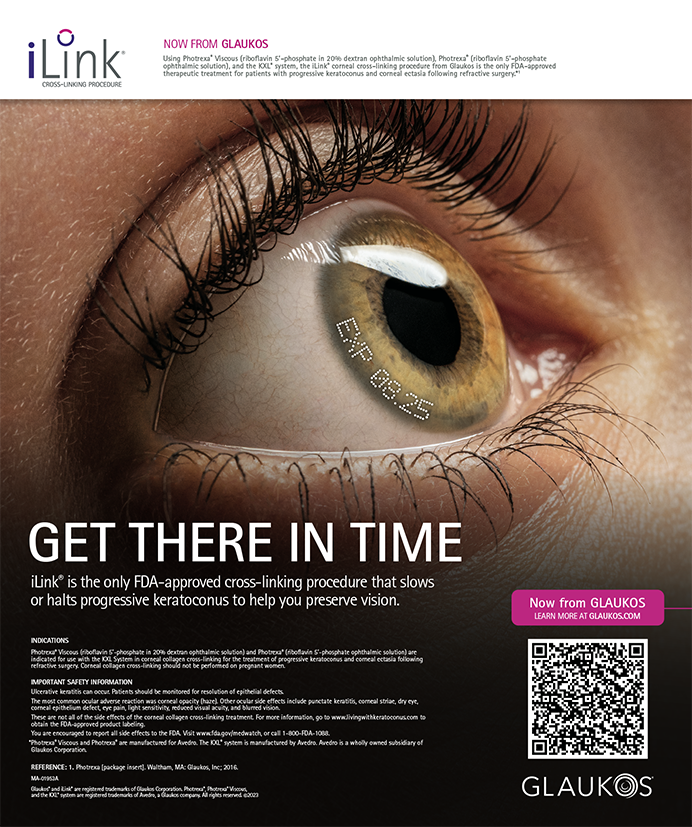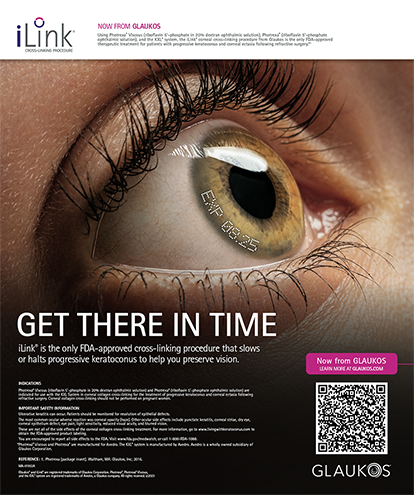In spite of several recent innovations in cataract surgery, eyes with small pupils are always surgically challenging. Intracameral mydriatics are an effective and safe addition to topical mydriatics in phacoemulsification.1 In some cases, they can enhance the effect of topical medications and, in certain groups, may reduce the risk of cardiovascular side effects. Unfortunately, the current pharmacological approaches for managing a small pupil during cataract surgery have limitations. If these agents fail, many surgeons decide to dilate the pupil mechanically at the time of the surgery.
There is no one universal recommendation or solution to the problem of a small pupil, because the strategies for pupillary enlargement greatly depend on the surgeon's level of skill and preferences as well as on the intraoperative situation. There are four main surgical methods: synechiolysis; mechanical stretching; cutting; and iris retraction. In synechiolysis, the surgeon separates the adhesions between the iris, the lens capsule, and/or the cornea. The technique of pupillary membranectomy with a forceps developed by Robert Osher, MD,2 is also effective in some cases.
Miller and Keener3 introduced the method of mechanically stretching the pupil. The technique is effective for small pupils with iris tissue that is rigid, usually due to a prior use of miotics, pseudoexfoliation, or posterior synechiae. The surgeon stretches the pupil with a spatula, a Sinskey hook, or a special instrument such as the Beehler pupil dilator.4 Usually, a pair of hooks introduced through two stab incisions in the cornea engages the iris sphincter. The surgeon then pulls the hooks in opposite directions and thus creates microscopic tears in the sphincter that enlarge the pupillary aperture.
The main advantages of mechanical pupillary stretching are that it is relatively simple and requires no special instrumentation. The procedure generally provides sufficient access to the lens and maintains the pupil's diameter intraoperatively. The drawback of this technique is that it permanently damages the iris sphincter. The microtears of the sphincter muscle are usually clinically asymptomatic, but they sometimes result in bleeding and pigment dispersion postoperatively. In a study of stretch pupilloplasty by Dinsmore,5 five of 50 patients developed an enlarged, atonic pupil postoperatively. All patients had a history of injury or inflammatory disease.
Partial-thickness cuts of the iris sphincter made with a microscissors is a common method of enlarging the pupil.6 This technique is controlled but requires multiple maneuvers of the scissors inside the anterior chamber, which can result in corneal endothelial damage. The method shares the disadvantages of the stretching method.
Suboptimal pupillary dilation in response to the preoperative mydriatic protocols and the minimal efficacy of pupillary stretching techniques are a usual indication for the intraoperative use of iris hooks or other mechanical devices. Retracting rather than cutting the iris tissue is simpler and results in much better postoperative cosmesis. Several devices for iris retraction are available.7,8 Traditionally, the surgeon places four evenly spaced retractors through limbal paracenteses located 90? apart from one another. The main corneal incision is centered on one of the four sides of the resultant square.9,10 During the iris hook's engagement of the pupillary edge, the instrument may catch and damage the capsule such that an anterior capsular tear extends to the periphery. The other disadvantage of iris retractors is the necessity of additional incisions.
Most of the surgical maneuvers for enlarging the pupil and preventing its intraoperative constriction can increase the risk of a torn iris sphincter, bleeding, damage to the iris, posterior capsular tears, and the loss of the vitreous body. Postoperative complications can include an atonic pupil of irregular shape and photophobia. Intraoperative iris manipulations may lead to a severe postoperative fibrinoid reaction, especially in patients with pseudoexfoliation syndrome, chronic uveitis, glaucoma, or diabetes.
The difficulty of performing cataract surgery in the presence of a small pupil led me to design the IQ-ring (manufactured by the S. Fyodorov Eye Microsurgery Complex, Moscow, Russia; not currently available in the US). This device is an appropriate means of approaching these challenging eyes, including those with intraoperative floppy iris syndrome.
DESIGN
The IQ-ring is indicated for cases of pupillary miosis that are refractory to dilation protocols. The device is a square, O-shaped, temporary implant. The one-piece plate design features four circular curls located at equidistant points on the ring (Figure 1A) that provide balanced stretching of and gently hold the iris tissue (Figure 1B).
SURGICAL TECHNIQUE
The ring is usually inserted at the beginning of the phaco procedure. After administering topical lidocaine 2, I make a paracentesis incision at the 12-o'clock position and create a 2.8-mm, temporal, clear corneal incision with a disposable metal blade. I inject a cohesive ophthalmic viscosurgical device into the anterior chamber to stabilize it and protect the corneal endothelium.
Next, I use a Sinskey hook to introduce the IQ-ring into the anterior chamber through the clear corneal phaco incision (Figure 2A). The device lies flat on the iris, and I attach it to the pupillary margin in a circular manner. The ring's implantation creates a square, 6-mm pupil that allows for safe and comfortable maneuvers during phacoemulsification (Figure 2B).
The IQ-ring provides stable mydriasis with no trauma to the iris tissue and no need for additional paracenteses. It retracts the iris away from the irrigating flow and thus helps to prevent the tissue's incarceration in the ultrasound and I/A handpieces. No change in the ophthalmologist's customary surgical technique is necessary. The capsulorhexis, hydrodissection, phacoemulsification (Figure 3), and injection of the IOL may occur with the device in place.
After implanting the lens, I loosen the IQ-ring from the pupillary margin with a Sinskey hook and lay the device on the iris. Next, I cut the ring with a Vannas scissors and use a forceps to withdraw it from the anterior chamber through the clear corneal incision (Figure 4).
POSTOPERATIVE RESULTS
The IQ-ring has been implanted in more than 500 eyes in different clinics across Russia. On the first postoperative day, patients have presented with minor cell and flare in the anterior chamber. The pupillary margin has been minimally disturbed or undamaged, and the IOL has been well centered.
ADVANTAGES
Adequate transpupillary access to the lens is essential to the success of phaco procedures, especially in eyes with zonular and capsular weakness. The IQ-ring offers several advantages over other methods of iris retraction. First, the device does not require additional incisions. Its insertion through the main phaco incision reduces surgical trauma and minimizes the risk of a postoperative inflammatory reaction.
Additionally, the ring applies pressure to the sphincter muscle over a wider area compared with iris hooks. The IQ-ring is particularly useful in eyes in which the cutting or tearing of the iris tissue should be avoided (eg, in the presence of rubeosis, chronic anterior uveitis, or systemic coagulopathy). The rim of the iris is safely fixed in the curls of the ring, and there is no risk of aspirating the iris during phacoemulsification. The equidistant curls of the ring hold the iris tissue without overstretching the pupil, as can occur with incorrectly positioned iris hooks.
Compared with iris retractors, the IQ-ring is gentler to the eye, due to its well-distributed stretching and light holding of the delicate iris tissue. Moreover, unlike iris retractors, the ring has no sharp points that can damage the eye. An unpublished study of 20 cadaveric eyes gave evidence of the ring's minimal impact on iris tissue. The surgeon created a clear corneal incision, implanted the IQ-ring, performed ultrasonically assisted phaco aspiration, and inserted a foldable IOL in 10 eyes. In the control group of 10 eyes, he inserted polymer iris hooks through four corneal paracenteses to hold the pupillary margin. At the end of the procedure, the surgeon filled the anterior chamber with balanced salt solution, hydrated the incisions to ensure that they were watertight, and excised the cornea with a 10-mm trephine. He then carefully removed the iris and prepared it for scanning electron microscopy, which showed that the IQ-ring produced much less damage to the pigmented iris tissue compared with conventional iris retractors (Figure 5).
Finally, the IQ-ring provides sufficient room for nuclear fragmentation and removal. Its design allows the surgeon to work in the deep lenticular layers below the iris plane. There is ample space for grooving and cutting the nucleus and increased peripheral visualization during the chopping phase of the procedure.
CONCLUSION
The IQ-ring is easy to insert and remove. Because the device adequately dilates the pupil without damaging the iris sphincter, the pupil may return to its normal shape, size, and function postoperatively (Figure 6). The careful insertion of the IQ-ring combined with the liberal use of ophthalmic viscosurgical devices can help prevent complications. Most of my patients' pupils have been almost identical in appearance before and after surgery. I have used the IQ-ring for cases of intraoperative floppy iris syndrome with great success.
Boris Malyugin, MD, PhD, is Chief of the Department of Cataract and Implant Surgery and Deputy Director General at the S. Fyodorov Eye Microsurgery Complex State Institution in Moscow. He acknowledged no financial interest in the product mentioned herein. Dr. Malyugin may be reached at 7 095 4113216; malyugin@online.ru.


